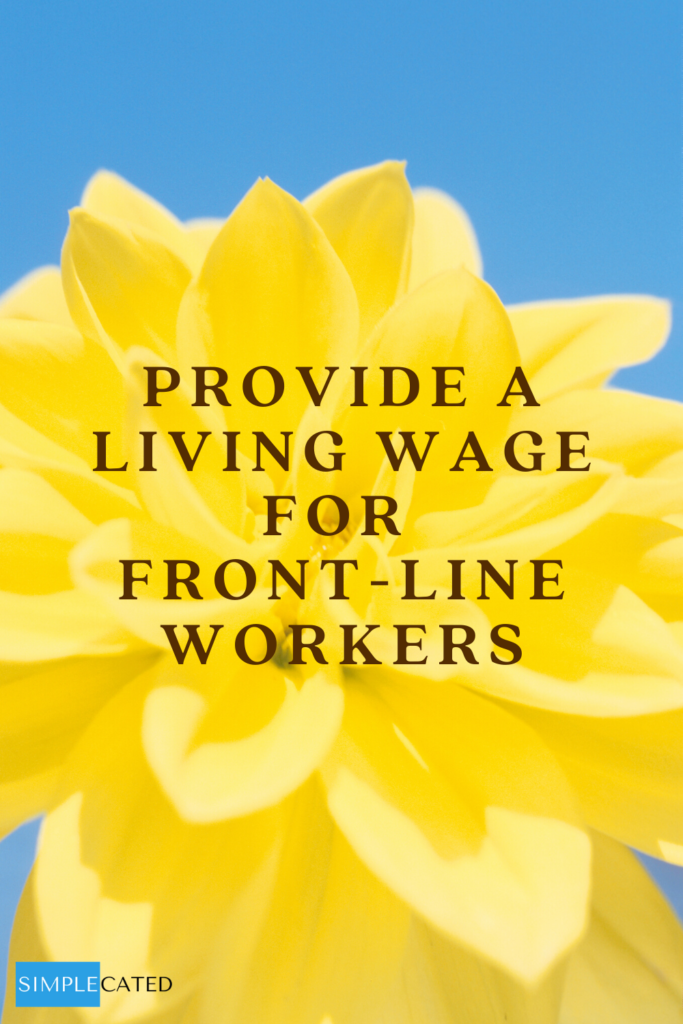As the weeks of this pandemic stretch on, we’re coming to really appreciate the jobs and employees we rely on to keep our everyday life intact. Certainly, healthcare workers quickly come to mind, and some healthcare jobs will fall into the scope of this article. Our focus today is on front-line workers in a variety of industries we deeply depend on – from grocery store cashiers and those who stock the shelves to meat plant workers and those who package our toilet paper. Jobs like these tend to be your lower-paying jobs, but without them, we’d have trouble meeting our own basic needs. They ensure we’re taken care of. Are we returning the favor?
We’re seeing the importance of income. The amount of money an employee has been making is impacting quality of life during the pandemic, especially in situations of furloughs or layoffs. It all happened so fast there really wasn’t time to make additional preparations. Ready or not, everything changed.
As businesses have started reopening and recalling their workers, some employers are finding that their employees aren’t very interested in returning due to the amount of unemployment benefits they’re receiving. Unemployment benefits vary widely by state, and there’s a very helpful recent CNBC article that outlines this. The Coronavirus Aid, Relief, and Economic Security (CARES) Act added an extra $600 a week to unemployment benefits right now, which is a substantial addition.
Granted, there could be additional reasons an employee might not want to return onsite, but if an extra $600 per week is enough for an employee to prefer staying home, that should be concerning to employers. Are those leaders providing the types of wages that truly take care of their employees?
The pandemic has also cast a spotlight on food insecurity. According to the Center on Budget and Policy Priorities, there were 38 million participants in SNAP (Supplemental Nutrition Assistance Program) in 2019. That’s 12% of the U.S. population! Working families accounted for more than 43% of the participants, and families with children accounted for more than 67%. And this was before the pandemic!
Given that SNAP benefits are provided to households below or close to the poverty line, it causes us to ask – what is the poverty line? It varies by size of the household. For a family of 3 in 2020, the poverty line is considered to be $1,778 per month. A household’s gross monthly income generally can’t be greater than 130% of the poverty line, so about $27,700 per year for a family of 3.
That brings us to federal minimum wage. While some states have a higher minimum wage, the federal minimum wage is $7.25, which applies to employees who are covered under the Fair Labor Standards Act (FLSA). This means a full-time employee working 40 hours/week makes $15,080 per year (roughly $1,256 a month).
This means that a single parent with 2 children who works full-time making minimum wage lives below the poverty line.
Even a household with 2 working parents and 1 child would be making just over $30,000, which is still very close to the poverty line.
On top of that, a Charles Schwab survey last year found that 59% of Americans live paycheck to paycheck. Add an emergency expense, loss of a job, or unanticipated circumstance like this pandemic, and it’s a recipe for disaster.
Now, I can probably guess what you’re thinking – “It’s not my fault!” You provide a certain pay rate, but you don’t control everything. And you’re right. Your personal financial situation is the result of your income plus a series of other factors and decisions, some within your control and others outside of your control. It’s like that with everyone. But as we all can agree, income is an important part of this equation.
As managers, it’s time to own your piece of the pie.
If you pay the federal minimum wage to an employee, it’s very likely that employee is living near the poverty line. Even if you already pay more than this, it’s possible it still doesn’t provide a living wage to your employees. Consider what it costs to have a decent standard of living in your area. Congresswoman Katie Porter provided a great example of how to calculate this as she outlined the monthly shortfall for a single mother working full-time and making $16.50 per hour.
Budgets are absolutely important, and pay ranges are strategic business decisions that are part of an overall compensation package you give to each employee. But shouldn’t one of your core business principles be providing a way for your employees to make ends meet?
Consider raising the minimum wage for your company. If you can organize your budget in such a way that you’re able to offer wages that help all of your employees to be above the poverty line and avoid food insecurity, think of what a huge win that is for everyone. Providing a living wage for front-line workers is a very tangible way to show that you truly value them. You’ll have shown that you understand that, while every job is important, your company wouldn’t exist at all if you didn’t have employees in these jobs.
I’ll never forget getting to sit across from plant workers and tell them their pay was increasing. It was an incredibly humbling experience. Many of them had been at the plant for years (some of them for decades) and were very loyal employees. We’d worked for a while on a market review of their jobs and making sure we had the budget to support pay increases for them, so it was very exciting to be able to deliver the news. I remember one employee crying when she saw her new pay rate and telling us how helpful it was going to be for her. Knowing we were helping people’s wellbeing made it all worth it.
What should I pay my employees is an important strategic question. As we reflect on this pandemic and take steps forward, it’s a great opportunity to evaluate ways you can adjust your budget to prioritize what truly matters, including the wellbeing of your employees. We’ve learned so much these last few weeks about the importance of taking care of each other and being “all in this together.” Ensure you’re providing a living wage for all of your employees. Doing what’s within your control to provide your employees the ability to avoid food insecurity and have a decent standard of living is a very important next step. You’ll likely gain some very loyal employees (and maybe loyal customers too) who will stay with you for a long time.
If you need help navigating this conversation with your leadership, reach out, and I’m happy to help. If you make these changes, leave a comment sharing what happened because that’s worth celebrating!
Photo credit: By anyaberkut / Canva






Very good points! Yes! When I decided to be an entrepreneur my family (still) looks at me like I have two heads but I was tired of working 60+hour weeks for what I could make working part-time as a food delivery driver! And no more having the dreaded conversations with my staff that, no, the company could not give you a raise. Thank you this is perfect!
I think your decision sounds great! It’s amazing what you can discover you’re making per hour based on the number of hours you’re putting in.